Extend Pumpkin Lifespan: Mastery in Preservation Techniques

ADVERTISEMENT
Pumpkins take center stage during the autumn season, offering a canvas for delectable dishes. Whether crafting a pumpkin pie or simmering a savory pumpkin soup, unlocking the full potential of this versatile vegetable requires finesse and insider know-how.
Pristine Pumpkin Preservation
Begin your pumpkin adventure with a pristine canvas. According to The Spruce Eats, start by giving the pumpkin a refreshing wash in cool water, clearing away any exterior dust or debris. Trim the stem, cut the pumpkin in half, and expertly scoop out the seeds and stringy bits. This sets the stage for a culinary masterpiece.
Cooking Techniques Unleashed

The Old Farmer’s Almanac suggests two key cooking methods to elevate your pumpkin creations. Roasting in the oven at 325ºF (168°C) until tender is a classic choice. Alternatively, steam the pumpkin over boiling water until soft and transform it into a delightful mash or puree using a blender or food processor.
Choosing the Perfect Pumpkin
Selecting the right pumpkin for your culinary endeavor is an art. Consider the following factors:
Size and Shape Matters
Opt for smaller pumpkins, like sugar pumpkins, renowned for their sweet and dense flesh. Their compact, round shape makes them a top choice for cooking.
Color and Texture Excellence
A deep orange hue signals ripeness and sweetness. Ensure the pumpkin’s flesh is firm and smooth, devoid of soft spots or bruises. Shiny skin may indicate an underripe pumpkin.
Stem and Weight Wisdom
A sturdy stem attached firmly is a mark of freshness. Heavy pumpkins signify moisture and flavor abundance, promising a culinary delight.
Read More : Preserving Eggs Without Refrigeration: Time-Tested Techniques
Pumpkin Preservation Mastery
To extend the lifespan of your pumpkins, proper storage is key.
ADVERTISEMENT
Temperature and Humidity Control
Maintain an ideal storage temperature between 10 and 15 degrees Celsius with humidity ranging from 50 to 70 percent. Opt for cool, dark places like a garage or cellar to prevent rot.
Pest Prevention Protocol
Safeguard your pumpkins from pests by washing them with a mild soap and water solution. Keep them away from ethylene-producing fruits like apples and bananas to stave off premature ripening.
Harvesting Hacks
Gardening Know How recommends cutting the stem with precision, leaving 3 to 4 inches attached. Harvest before the first frost or bring them indoors if inclement weather threatens the crop.
Preparation Prodigy
Achieving a flawless pumpkin for cooking involves meticulous preparation steps.
Exterior Elegance
Clean the pumpkin’s exterior with cool water, eliminating any dirt or debris. A gentle rinse is sufficient to prepare it for the culinary journey.
Cut, Clean, and Carve
Trim the stem, cut the pumpkin in half, and scoop out seeds and fibers with ease. Depending on the recipe, peel and slice the pumpkin, taking care to avoid injuries.
Culinary Chronicles: Cooking Methods
Various cooking methods can bring out distinct flavors in your pumpkin creations. Choose the one that aligns with your culinary vision.
Roasting Radiance
Cut the pumpkin into pieces, drizzle with oil, season, and roast at 400°F for 45 minutes. Revel in the natural sweetness that roasting extracts.
Boiling Brilliance
Quick and easy, boiling involves cutting the pumpkin into pieces, boiling until tender, and mashing for diverse culinary applications.
Steaming Splendor
Preserve nutrients with steaming. Cut the pumpkin into pieces, steam until tender, and scoop the flesh for a nutrient-packed addition to your dishes.
Grilling Grandeur
Infuse a smoky flavor by grilling thick pumpkin slices brushed with oil, seasoned, and grilled until tender and lightly charred.
Nutrient Nectar: Pumpkin’s Health Bounty
Pumpkin emerges as a nutritional powerhouse, offering an array of vitamins, minerals, and antioxidants.
Vitamin and Mineral Marvel
Loaded with vitamin A, pumpkin supports vision, skin, and immune health. It also boasts vitamin C and potassium, contributing to collagen production and healthy blood pressure.
Dietary Fiber Dynamo
A rich source of dietary fiber, pumpkin aids digestive health, lowers cholesterol, and reduces the risk of heart disease.
Antioxidant Arsenal
Packed with antioxidants like beta-carotene, pumpkin shields the body from free radicals, curbing the risk of chronic diseases.
Incorporate pumpkin into your diet for a myriad of health benefits. Explore recipes at Healthline for more pumpkin-inspired culinary creations.
Culmination: Pumpkin Panorama
In conclusion, embrace the versatility and nutrition of pumpkins. From savory soups to sweet desserts, the possibilities are endless. The key lies in choosing the right pumpkin, mastering preparation, and experimenting with diverse cooking techniques.
FAQs for the Pumpkin Enthusiast
What are some popular pumpkin recipes?
Explore the versatility of pumpkin with recipes like pumpkin pie, soup, roasted pumpkin, pumpkin bread, and risotto. Get creative with smoothies, pancakes, and muffins.
How should I prepare pumpkin for cooking?
Start by washing the pumpkin, cutting off the stem, and scooping out seeds. Depending on the recipe, peel or leave the skin on, and cut into chunks or slices as needed.
How can I enhance the taste of pumpkin dishes?
Elevate pumpkin flavor with spices like cinnamon, nutmeg, ginger, or cloves. Sweeten with brown sugar, honey, or maple syrup. For savory dishes, experiment with garlic, onion, or aromatic herbs.
Any creative uses for pumpkin seeds?
Roast pumpkin seeds for a healthy snack or garnish. Rinse, toss with oil and salt, and bake until golden brown.
To peel or not to peel pumpkin before cooking?
Peel if mashing or pureeing; leave the skin for roasting or soups to preserve shape and add flavor.
Tips for safe pumpkin carving?
Start by washing the pumpkin, cut and scoop out seeds. Use a sharp knife or carving tool away from yourself. Illuminate with a tea light or battery-operated candle.
Unleash your pumpkin prowess, savor the flavors, and enjoy the journey of creating culinary magic with this versatile and nutritious vegetable.
ADVERTISEMENT